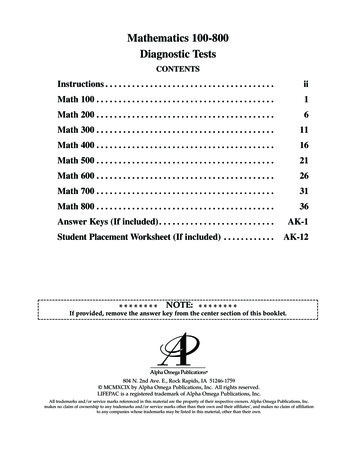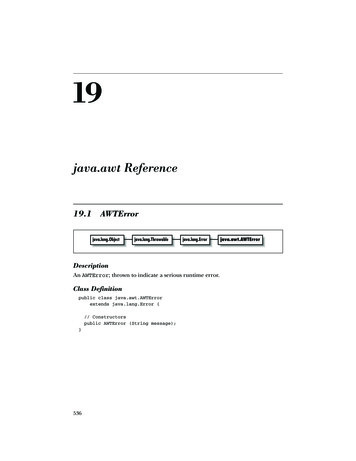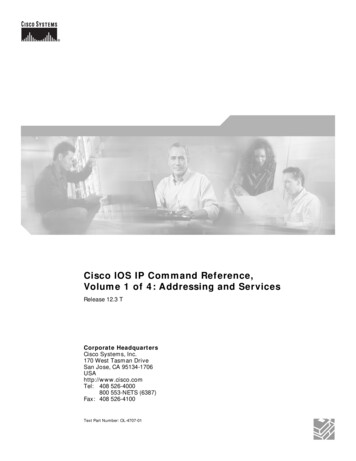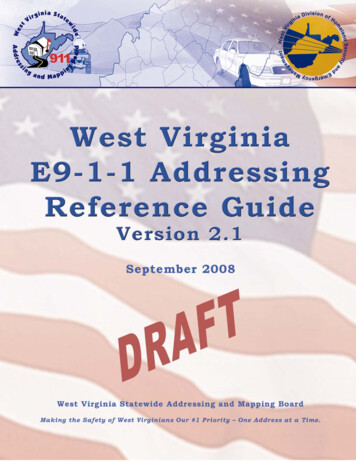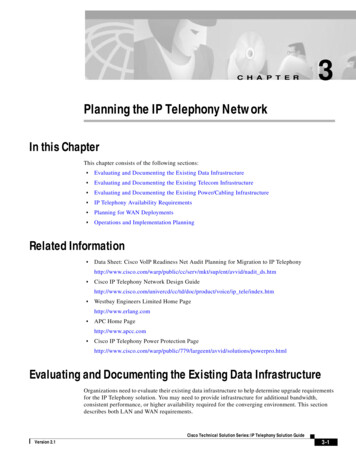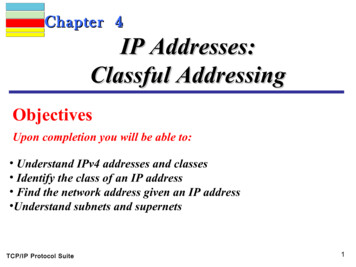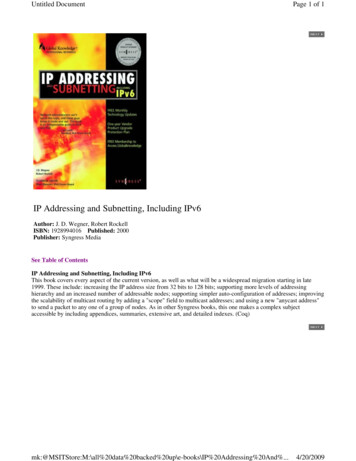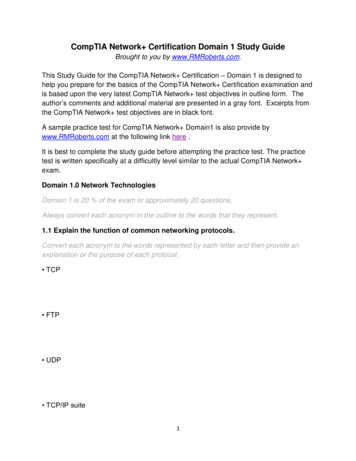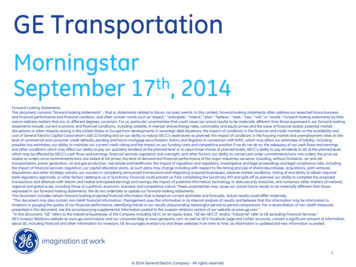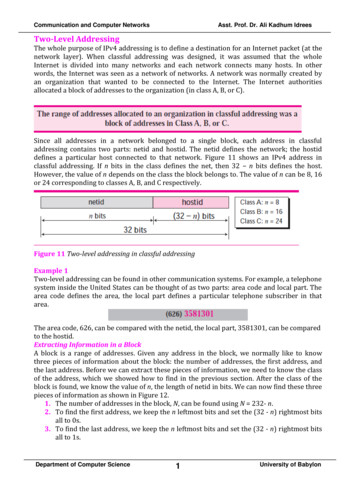
Transcription
Communication and Computer NetworksAsst. Prof. Dr. Ali Kadhum IdreesTwo-Level AddressingThe whole purpose of IPv4 addressing is to define a destination for an Internet packet (at thenetwork layer). When classful addressing was designed, it was assumed that the wholeInternet is divided into many networks and each network connects many hosts. In otherwords, the Internet was seen as a network of networks. A network was normally created byan organization that wanted to be connected to the Internet. The Internet authoritiesallocated a block of addresses to the organization (in class A, B, or C).Since all addresses in a network belonged to a single block, each address in classfuladdressing contains two parts: netid and hostid. The netid defines the network; the hostiddefines a particular host connected to that network. Figure 11 shows an IPv4 address inclassful addressing. If n bits in the class defines the net, then 32 n bits defines the host.However, the value of n depends on the class the block belongs to. The value of n can be 8, 16or 24 corresponding to classes A, B, and C respectively.Figure 11 Two-level addressing in classful addressingExample 1Two-level addressing can be found in other communication systems. For example, a telephonesystem inside the United States can be thought of as two parts: area code and local part. Thearea code defines the area, the local part defines a particular telephone subscriber in thatarea.The area code, 626, can be compared with the netid, the local part, 3581301, can be comparedto the hostid.Extracting Information in a BlockA block is a range of addresses. Given any address in the block, we normally like to knowthree pieces of information about the block: the number of addresses, the first address, andthe last address. Before we can extract these pieces of information, we need to know the classof the address, which we showed how to find in the previous section. After the class of theblock is found, we know the value of n, the length of netid in bits. We can now find these threepieces of information as shown in Figure 12.1. The number of addresses in the block, N, can be found using N 232- n.2. To find the first address, we keep the n leftmost bits and set the (32 - n) rightmost bitsall to 0s.3. To find the last address, we keep the n leftmost bits and set the (32 - n) rightmost bitsall to 1s.Department of Computer Science1University of Babylon
Communication and Computer NetworksAsst. Prof. Dr. Ali Kadhum IdreesFigure 12 Information extraction in classful addressingExample 2An address in a block is given as 73.22.17.25. Find the number of addresses in the block, thefirst address, and the last address.SolutionSince 73 is between 0 and 127, the class of the address is A. The value of n for class A is 8.Figure 13 shows a possible configuration of the network that uses this block. Note that weshow the value of n in the network address after a slash. Although this was not a commonpractice in classful addressing, it helps to make it a habit in classless addressing in the nextsection.Figure 13 Solution to Example 21. The number of addresses in this block is N 232-n 224 16,777,216.2. To find the first address, we keep the leftmost 8 bits and set the rightmost 24 bits all to 0s.The first address is 73.0.0.0/8 in which 8 is the value of n. The first address is called thenetwork address and is not assigned to any host. It is used to define the network.3. To find the last address, we keep the leftmost 8 bits and set the rightmost 24 bits all to 1s.The last address is 73.255.255.255. The last address is normally used for a special purpose, asdiscussed later in the chapter.Department of Computer Science2University of Babylon
Communication and Computer NetworksAsst. Prof. Dr. Ali Kadhum IdreesExample 3An address in a block is given as 180.8.17.9. Find the number of addresses in the block, thefirst address, and the last address.SolutionSince 180 is between 128 and 191, the class of the address is B. The value of n for class B is 16.Figure 14 shows a possible configuration of the network that uses this block.Figure 14 Solution to Example 31. The number of addresses in this block is N 232-n 216 65,536.2. To find the first address, we keep the leftmost 16 bits and set the rightmost 16 bits all to 0s.The first address (network address) is 18.8.0.0/16, in which 16 is the value of n.3. To find the last address, we keep the leftmost 16 bits and set the rightmost 16 bits all to 1s.The last address is 18.8.255.255.Example 4An address in a block is given as 200.11.8.45. Find the number of addresses in the block, thefirst address, and the last address.SolutionSince 200 is between 192 and 223, the class of the address is C. The value of n for class C is 24.Figure 5.18 shows a possible configuration of the network that uses this block.1. The number of addresses in this block is N 232-n 28 256.2. To find the first address, we keep the leftmost 24 bits and set the rightmost 8 bits all to 0s.The first address is 200.11.8.0/24. The first address is called the network address.3. To find the last address, we keep the leftmost 24 bits and set the rightmost 8 bits all to 1s.The last address is 200.11.8.255.Figure 15 Solution to Example 4Department of Computer Science3University of Babylon
Communication and Computer NetworksAsst. Prof. Dr. Ali Kadhum IdreesAn ExampleFigure 16 shows a hypothetical part of an internet with three networks.Figure 16 Sample internetWe have1. A LAN with the network address 220.3.6.0 (class C).2. A LAN with the network address 134.18.0.0 (class B).3. A switched WAN (class C), such as Frame Relay or ATM, that can be connected to manyrouters. We have shown three. One router connects the WAN to the left LAN, one connects theWAN to the right LAN, and one connects the WAN to the rest of the internet.Network AddressThe above three examples show that, given any address, we can find all information about theblock. The first address, network address, is particularly important because it is used inrouting a packet to its destination network. For the moment, let us assume that an internet ismade of m networks and a router with m interfaces. When a packet arrives at the router fromany source host, the router needs to know to which network the packet should be sent; therouter needs to know from which interface the packet should be sent out. When the packetarrives at the network, it reaches its destination host using another strategy that we discuss inlater chapters. Figure 17 shows the idea. After the network address has been found, the routerconsults its routing table to find the corresponding interface from which the packet should besent out. The network address is actually the identifier of the network; each network isidentified by its network address.Department of Computer Science4University of Babylon
Communication and Computer NetworksAsst. Prof. Dr. Ali Kadhum IdreesFigure 17 Network addressNetwork MaskThe methods we described previously for extracting the network address are mostly used toshow the concept. The routers in the Internet normally use an algorithm to extract thenetwork address from the destination address of a packet. To do this, we need a networkmask. A network mask or a default mask in classful addressing is a 32-bit number with nleftmost bits all set to 1s and (32 - n) rightmost bits all set to 0s. Since n is different for eachclass in classful addressing, we have three default masks in classful addressing as shown inFigure 18.Figure 18 Network maskTo extract the network address from the destination address of a packet, a router uses theAND operation described in the previous section. When the destination address (or anyaddress in the block) is ANDed with the default mask, the result is the network address(Figure 19). The router applies the AND operation on the binary (or hexadecimalrepresentation) of the address and the mask, but when we show an example, we use the shortcut discussed before and apply the mask on the dotted-decimal notation. The default mask canalso be used to find the number of addresses in the block and the last address in the block, butwe discuss these applications in classless addressing.Department of Computer Science5University of Babylon
Communication and Computer NetworksAsst. Prof. Dr. Ali Kadhum IdreesFigure 19 Finding a network address using the default maskExample 5A router receives a packet with the destination address 201.24.67.32. Show how the routerfinds the network address of the packet.SolutionWe assume that the router first finds the class of the address and then uses the correspondingdefault mask on the destination address, but we need to know that a router uses anotherstrategy as we will discuss in the next chapter. Since the class of the address is B, we assumethat the router applies the default mask for class B, 255.255.0.0 to find the network address.Three-Level Addressing: SubnettingAs we discussed before, the IP addresses were originally designed with two levels ofaddressing. To reach a host on the Internet, we must first reach the network and then thehost. It soon became clear that we need more than two hierarchical levels, for two reasons.First, an organization that was granted a block in class A or B needed to divide its largenetwork into several subnetworks for better security and management. Second, since theblocks in class A and B were almost depleted and the blocks in class C were smaller than theneeds of most organizations, an organization that has been granted a block in class A or Bcould divide the block into smaller subblocks and share them with other organizations. Theidea of splitting a block to smaller blocks is referred to as subnetting. In subnetting, anetwork is divided into several smaller subnetworks (subnets) with each subnetwork havingits own subnetwork address.Example 6Three-level addressing can be found in the telephone system if we think about the local partof a telephone number as an exchange and a subscriber connection:in which 626 is the area code, 358 is the exchange, and 1301 is the subscriber connection.Department of Computer Science6University of Babylon
Communication and Computer NetworksAsst. Prof. Dr. Ali Kadhum IdreesExample 7Figure 20 shows a network using class B addresses before subnetting. We have just onenetwork with almost 216 hosts. The whole network is connected, through one singleconnection, to one of the routers in the Internet. Note that we have shown /16 to show thelength of the netid (class B).Figure 20 Example 7Example 8Figure 21 shows the same network in Figure 20 after subnetting. The whole network is stillconnected to the Internet through the same router. However, the network has used a privaterouter to divide the network into four subnetworks. The rest of the Internet still sees only onenetwork; internally the network is made of four subnetworks. Each subnetwork can now havealmost 214 hosts. The network can belong to a university campus with four different schools(buildings). After subnetting, each school has its own subnetworks, but still the whole campusis one network for the rest of the Internet. Note that /16 and /18 show the length of the netidand subnetids.Subnet MaskWe discussed the network mask (default mask) before. The network mask is used when anetwork is not subnetted. When we divide a network to several subnetworks, we need tocreate a subnetwork mask (or subnet mask) for each subnetwork. A subnetwork has subnetidand hostid as shown in Figure 22.Department of Computer Science7University of Babylon
Communication and Computer NetworksAsst. Prof. Dr. Ali Kadhum IdreesFigure 21 Example 8Figure 22 Network mask and subnetwork maskSubnetting increases the length of the netid and decreases the length of hostid. When wedivide a network to s number of subnetworks, each of equal numbers of hosts, we cancalculate the subnetid for each subnetwork asin which n is the length of netid, nsub is the length of each subnetid, and s is the numberof subnets which must be a power of 2.Example 9In Example 8, we divided a class B network into four subnetworks. The value of n 16 and thevalue of n1 n2 n3 n4 16 log24 18. This means that the subnet mask has eighteen 1sand fourteen 0s. In other words, the subnet mask is 255.255.192.0 which is different from thenetwork mask for class B (255.255.0.0).Department of Computer Science8University of Babylon
Communication and Computer NetworksAsst. Prof. Dr. Ali Kadhum IdreesSubnet AddressWhen a network is subnetted, the first address in the subnet is the identifier of the subnet andis used by the router to route the packets destined for that subnetwork. Given any address inthe subnet, the router can find the subnet mask using the same procedure we discussed tofind the network mask: ANDing the given address with the subnet mask. The short cuts wediscussed in the previous section can be used to find the subnet address.Example 10In Example 8, we show that a network is divided into four subnets. Since one of the addressesin subnet 2 is 141.14.120.77, we can find the subnet address as:The values of the first, second, and fourth bytes are calculated using the first short cut for ANDoperation. The value of the third byte is calculated using the second short cut for the ANDoperation.Designing SubnetsWe show how to design a subnet when we discuss classless addressing. Since classfuladdressing is a special case of classless addressing, what is discussed later can also be appliedto classful addressing.SupernettingSubnetting could not completely solve address depletion problems in classful addressingbecause most organizations did not want to share their granted blocks with others. Since classC blocks were still available but the size of the block did not meet the requirement of neworganizations that wanted to join the Internet, one solution was supernetting. Insupernetting, an organization can combine several class C blocks to create a larger range ofaddresses. In other words, several networks are combined to create a supernetwork. By doingthis, an organization can apply for several class C blocks instead of just one. For example, anorganization that needs 1000 addresses can be granted four class C blocks.Supernet MaskA supernet mask is the reverse of a subnet mask. A subnet mask for class C has more 1s thanthe default mask for this class. A supernet mask for class C has less 1s than the default maskfor this class. Figure 23 shows the difference between a subnet mask and a supernet mask. Asubnet mask that divides a block into eight subblocks has three more 1s (23 8) than thedefault mask; a supernet mask that combines eight blocks into one superblock has three less1s than the default mask.Department of Computer Science9University of Babylon
Communication and Computer NetworksAsst. Prof. Dr. Ali Kadhum IdreesFigure 23 Comparison of subnet, default, and supernet masksIn supernetting, the number of class C addresses that can be combined to make a supernetneeds to be a power of 2. The length of the supernetid can be found using the formulain which nsuper defines the length of the supernetid in bits and c defines the number of class Cblocks that are combined. Unfortunately, supernetting provided two new problems: First, thenumber of blocks to combine needs to be a power of 2, which means an organization thatneeded seven blocks should be granted at least eight blocks (address wasting). Second,supernetting and subnetting really complicated the routing of packets in the Internet.Department of Computer Science10University of Babylon
Figure 11 Two-level addressing in classful addressing Example 1 Two-level addressing can be found in other communication systems. For example, a telephone system inside the United States can be thought of as two parts: area code and local part. The area code defines the area, the local part defines a particular telephone subscriber in that area.

